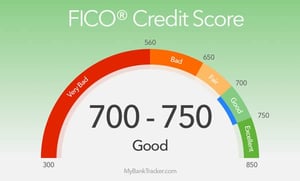
It wasn’t until my 20s that I really began to care about my credit score and it’s also the first time I wondered, “What is the highest credit score possible?” I also couldn’t help but wonder about the lowest credit score possible. This is also around the time a lot of free credit score tracking apps began to rise in popularity, making it super easy for anyone to access their score. Prior to the emergence of these apps, you generally had to pay to see your credit score.
Thankfully, that’s not the case anymore and Americans’ credit scores — and the scoring process — is much more transparent than it was in the past. Still, my 20-year-old self still didn’t understand the credit scoring parameters, so, though I could see my score, I didn’t really know where my credit stood. It’s kind of like an SAT score — if you don’t know what the highest and lowest possible scores are, do you really know how well you did on the test?
In the following article, we’ll dive into the ins and outs of the most commonly used credit rating scale and you can learn how your own credit score fits into the scale — and hopefully gain some knowledge about how to give it a boost and maintain a high score.
1. 850 Is the Best Credit Score Possible
The highest possible FICO credit score one can have is 850, and a credit score above 750 is generally regarded as “excellent” credit. The FICO credit score is the most widely used credit score by lenders to determine creditworthiness. The second most common credit score seen by lenders is the VantageScore 3.0, which also maxes out at 850.

This is the tier we should all strive to reach. Not only do consumers with excellent credit have the highest odds of approval when applying for loans and credit, they also have access to the best terms and rates.
2. Conversely, 300 is the Lowest Credit Score Possible
On the other end of the credit spectrum sits the number 300 — the lowest FICO credit score possible, representing the worst credit rating one can have. However, anything below 650 is generally regarded as having bad, or “poor”, credit.
With 750 and above representing excellent credit, and anything below 650 representing poor credit, the 100 points in the middle represent “fair” credit (650-699) and “good” credit (700-749). The average American credit score sits right above 700.
Credit Repair May Help Improve Your Score
For those with subprime credit, there are actions you can take to help improve your score, such as always paying your loan and credit statements on time and keeping the balance on your credit cards below 30% of its available limit. But when negative items like late payments and charge-offs — or, especially, inaccuracies and misinformation — on your credit report are keeping your score down, it might be time to refer to a credit specialist.
But when negative items like late payments and charge-offs — or, especially, inaccuracies and misinformation — on your credit report are keeping your score down, it might be time to refer to a credit specialist.
These types of negative items generally take seven years from the original delinquency date to be removed from your credit report, as specified by the Fair Credit Reporting Act. However, when disputed by a credit repair company, these items can be removed sooner, helping you to see positive results more quickly than by choosing to wait it out.
3. Only 0.5% of Americans Will Achieve a Perfect 850
Don’t be too hard on yourself if when you do check your credit score, it’s nowhere near the 850 mark — only 0.5% of Americans will ever achieve “perfect” credit. Even the bureaus refer to those who have a credit score above 785 as “high credit score achievers.”
A perfect SAT score may be required to get into a prestigious university, but you don’t need a perfect credit score to get the best loans. Banks aren’t holding out the best-of-the-best offers for those with perfect credit — these can usually be attained by anyone with a credit score above 760, according to FICO spokesman Anthony Sprauve.
Whether you’re 20, 30, or 80 years old, understanding your credit is the universal first step. Only then can you begin the process toward perfect credit — or nearly perfect — because we’ve learned it’s basically the same when it comes to the rates and terms you’ll receive.




